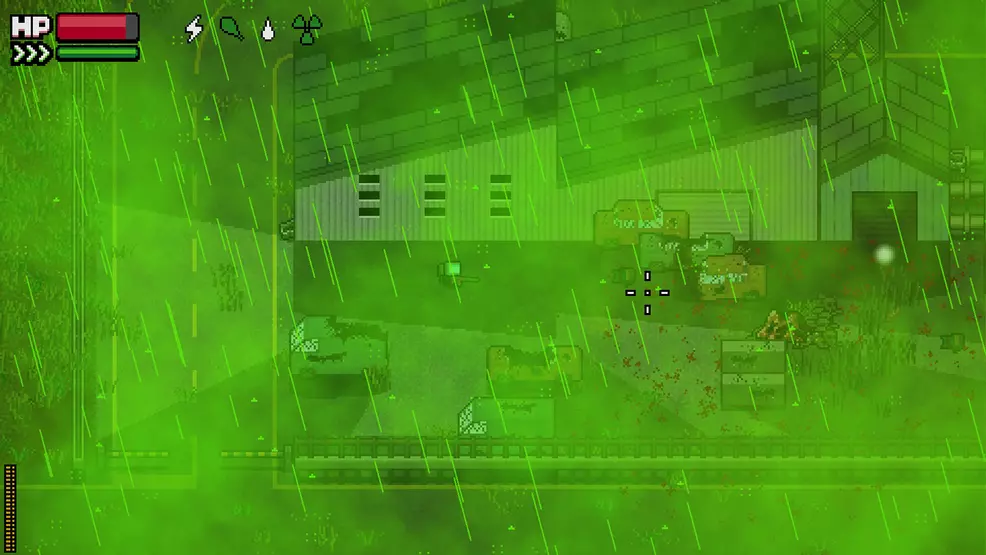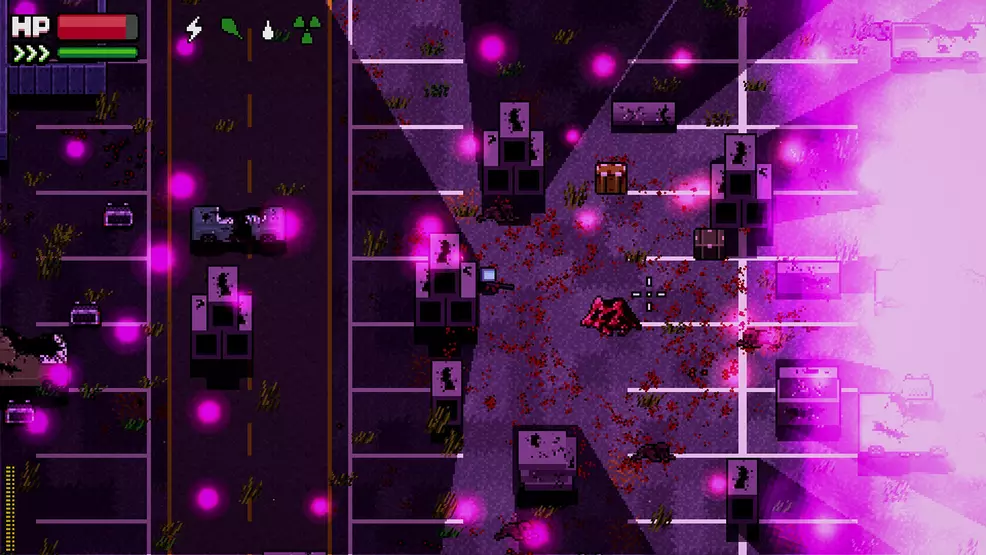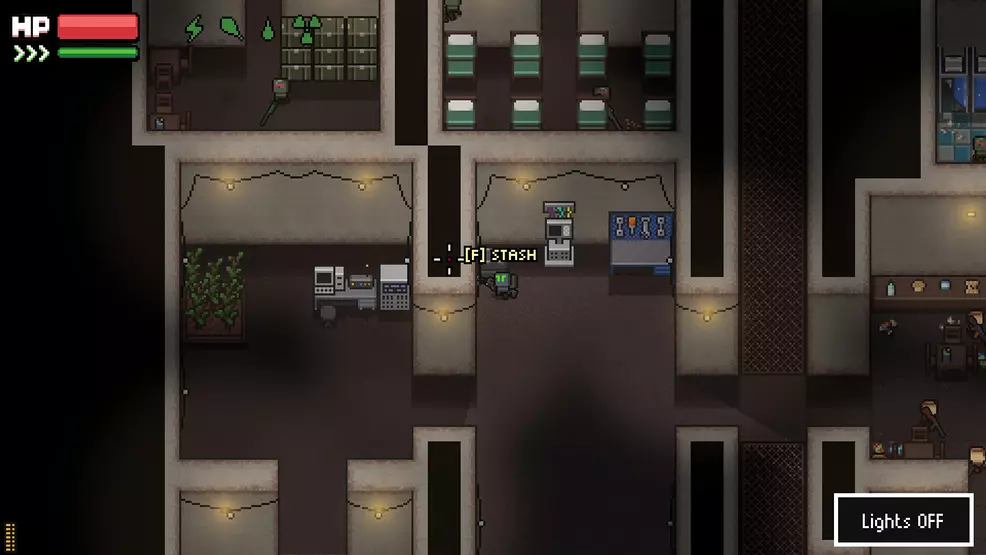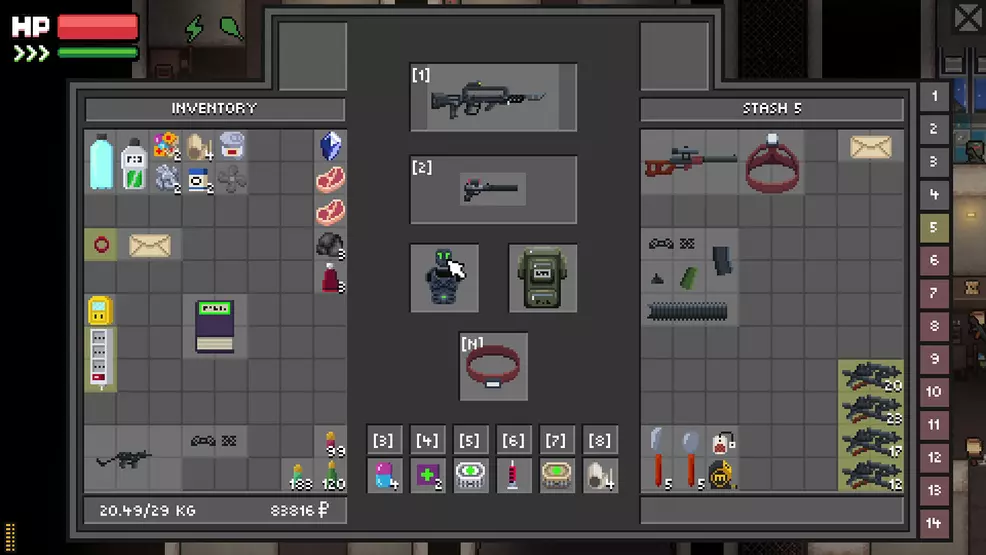Zero Sievert from Modern Wolf is a top-down pixel survival game where little bean-shaped characters try to grab as much as they can in the irradiated wilds and get out before something gets them first. On a good day, you can find a lot of trash to sell and even improve your character’s survival skills for the next run. My bean did not have a good day at first, and the four days after that weren’t particularly good either thanks to a combination of sudden bursts of flame and a few hungry and very rabid rabbits. Zero Sievert isn’t concerned about making life in the nuclear wasteland easy, and that’s a big reason why I couldn’t get enough of it.
It's the end of the world again

Zero Sievert follows a group of scavengers in a landscape ravaged by nuclear fallout. There’s not much left out in the world aside from ruins and death – but that just makes the valuables you do manage to scrounge up even more profitable. “Valuables” in Zero Sievert’s case means stuff like tires and cookware and tinned meat of questionable provenance, but even the most seemingly worthless piece of trash has a price.
There’s a story here, about survivors of the nuclear disaster and the depths people sink to when pushed to extremes, and you can put it together in bits and pieces after talking to people at your base and taking on qusts. It’s mostly just flavor to set the stage for your forays into the wilds, though Modern Wolf does deserve credit for blending its grim apocalyptic setting with a sense of ridiculous humor.

If you’ve played any kind of survival or extraction game in the last few years, you’re already familiar with how Zero Sievert works once you leave base. You travel to a location, avoid obstacles and death, pick up as much as you can, and leave before something does appalling things to you. Completing certain actions over time builds points toward skills, such as looting faster or carrying more, and you’ll pick up quests that push you toward completing specific tasks, like defeating X number of Y enemy.
The quests add a welcome sense of structure that push you to explore and try new things each time you venture out, though the skills are disappointingly rudimentary. Abilities such as healing more quickly or carrying more items are so standard that they hardly feel like accomplishments once you unlock them. Advanced skills are the exception and create little specializations, such as a pharmacist option that lets you craft injections or a chef option that increases food effects, though these are sadly few in number.
Don't trust the wildlife

Modern Wolf doesn’t innovate with Zero Sievert, in other words, but it doesn’t really have to. There’s a casual air about Zero Sievert that encourages quick playthroughs, thanks in part to how easy it is to start – and to die. There’s also enough depth to make each session feel exciting, no matter how many times you’ve tried and failed and failed again. Zero Sievert’s maps are partly to thank for that “pick up and play” feeling. They’re the perfect size and feel explorable without being overwhelming, with enough obstacles and secrets to make searching every corner rewarding. Zero Sievert is a bit too stingy with how it doles out experience points, you’re always making progress of some kind, even if it’s just learning what not to do next time. Like “don’t walk over the glowing orange spots because it’s deadly fire – not pretty bugs.”
Procedural generation is hit and miss in games like Zero Sievert, but Modern Wolf uses it particularly well for its maps. Take the introductory forest, for example. One run might give you a bandit camp near where you start, which pushes you in another direction to explore and avoid a dangerous confrontation. The next time, you might stumble on an abandoned garage full of loot – enough to fill your pockets and head back without bothering to explore further – and a homicidal dog or two. The phrase "one more turn" has become something of a trite description for absorbing games, but Zero Sievert balances its risks, rewards, and opportunities so well that it's so easy to invest far more time than you intended.
It's tough out there

Not exploring much might mean you get fewer rare rewards, but at the start at least, it’s a valid tactic. Zero Sievert is brutal, and the enemies feel slightly overtuned, even on standard difficulty levels. The aiming cursor is a little floaty and, when you factor in recoil, landing multiple shots in succession is rather more challenging than it should be. Enemies don’t have that problem and track you with inhuman accuracy. Normally, I’d expect getting obliterated by a single bandit in under five seconds to feel discouraging or frustrating. Zero Sievert makes getting back into the field so simple and frictionless, though, that it’s hardly more than a minor annoyance. Sure, you lost your loot, but you can just get back out there and try again.
The annoying thing is that you’re locked into whatever presets you pick. The menu’s difficulty section lets you see all the settings you chose, but you can’t adjust them in-game or from the start screen menu. That’s fine if you’re just getting started, buf if you’ve invested a fair amount of time in a save file and decide you want a change, you have to start a new game.

Still, Zero Sievert gives you plenty of tools to help you meet those challenges, even if you bloody your nose three dozen times before you finally get the materials to make them. Its weapon customization is exceptional and resembles something closer to Call of Duty than you might expect from what, at a glance, looks more like Vampire Survivors. You can customize with scopes, attachments, special muzzles, and magazines, or you can build a weapon that suits a stealthy playstyle if you’d rather play it safe – or both, since Zero Sievert gives you multiple weapon slots.
Zero Sievert might use a lot of familiar genre descriptors, such as roguelike and extraction shooter, and it might not do a whole lot different from other, similar games that came before. However, everything it does, it does just right. It rewards you enough to make the steep challenge worth putting up with. It pushes you to explore and experiment by making both goals feel achievable with the right plan and a bit of luck, and eventually, it gives you the tools to make some fantastically detailed weapon builds and take on even bigger challenges with bigger rewards on offer. It's all recognizable, sure, but when Zero Sievert is this fun, innovation doesn't really matter.
This review of Zero Sievert is based on a copy of the game the publisher provided. Zero Sievert is available now on PC via Steam.
Zero Sievert
- Excellent map design and procedural generation
- Strong balance of risk and reward
- Detailed and varied weapon build options
- Customizable difficulty options make it easy to enjoy at your own pace
- Annoying that you can't adjust the difficulty between sessions
- Only the advanced skills have something interesting to offer
-
Josh Broadwell posted a new article, Zero Sievert review: It's the end of the world, and I feel fine


